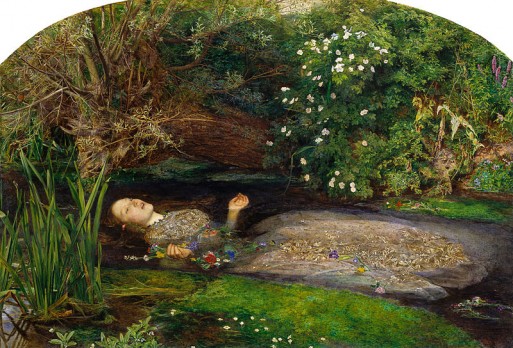Shakespeare has inspired countless artists, and painter John Everett Millais is no exception. His famous “Ophelia” painting was inspired by Hamlet, in which Hamlet’s lover, Ophelia, goes insane with grief after she discovers that Hamlet has murdered her father; in her distraught state, she eventually falls into a brook and drowns. However, in her announcement of the girl’s death, Queen Gertrude (Hamlet’s mother) remarks that Ophelia wasn’t unhappy before her death — that she was picking flowers just before she died, and while in the water, “she chanted snatches of old tunes,/As one incapable of her own distress” (4.7.201-202).
Millais chose to focus on this positive note rather than on the bleakness of the situation, and made the scene beautiful and bright, suggesting that death doesn’t have to be a dark and dismal occurrence. In the painting, Ophelia is surrounded by colorful flowers and plants, symbols of life and continuity, and her body seems to be one with the water; this signifies the concept of returning to the earth when one dies.
Though painted between 1851 and 1852, the meaning behind the image still resonates today: despite the assorted modern options for burial nowadays, many people are still choosing natural burial. (Natural burial typically involves no embalmment, and a simple coffin; there is usually no gravestone, so that the individual is truly a part of nature, rather than disrupting it. All of this combines to make for a basic, gentle return to the earth after death.) This shows that some things will never change, the way Shakespeare remains an important and influential figure today, almost 400 years later.
Sources: Tate Britain and Wikipedia
Related Reading:
- Other depictions of Ophelia
- “Is There Anything as Enchanting as the Meaning of Flowers?” (SevenPonds)

 The Significance of John Everett Millais’ “Ophelia”
The Significance of John Everett Millais’ “Ophelia”



 John Mulaney’s “Funeral Planning” on Netflix: No Real Plan
John Mulaney’s “Funeral Planning” on Netflix: No Real Plan

 Composting Bodies Is Now Legal in a Dozen States
Composting Bodies Is Now Legal in a Dozen States














